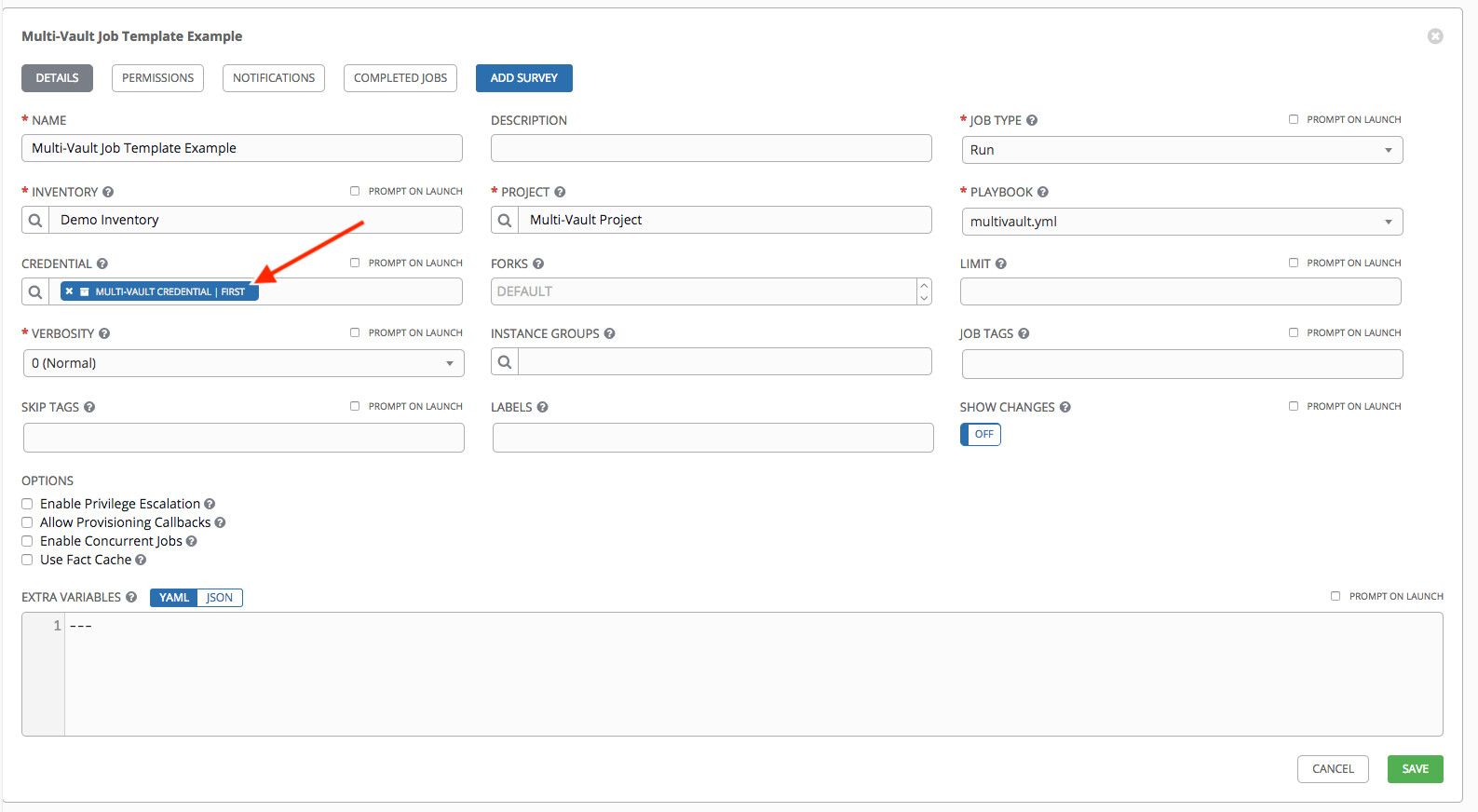5. Multi-Credential Assignment¶
Starting with version 3.3, Ansible Tower provides support for assigning zero or more credentials to a job template.
5.1. Background¶
Prior to Ansible Tower 3.3, job templates had a certain set of requirements with respect to credentials:
- All job templates (and jobs) were required to have exactly one Machine/SSH or Vault credential (or one of both).
- All job templates (and jobs) could have zero or more “extra” credentials.
- Extra credentials represented “Cloud” and “Network” credentials that could be used to provide authentication to external services via environment variables (e.g.,
AWS_ACCESS_KEY_ID).
This model required a variety of disjoint interfaces for specifying credentials on a job template and it lacked the ability associate multiple Vault credentials with a playbook run, a use case supported by Ansible core from Ansible 2.4 onwards.
This model also poses a stumbling block for certain playbook execution workflows, such as having to attach a “dummy” Machine/SSH credential to the job template simply to satisfy the requirement.
5.2. Important Changes¶
Job templates now have a single interface for credential assignment. From the API endpoint:
GET /api/v2/job_templates/N/credentials/
You can associate and disassociate credentials using POST requests, similar to the behavior in the deprecated extra_credentials endpoint:
POST /api/v2/job_templates/N/credentials/ {'associate': true, 'id': X'}
POST /api/v2/job_templates/N/credentials/ {'disassociate': true, 'id': Y'}
Under this model, a job template is considered valid even when there are no credentials assigned to it. This model also provides users the ability to assign multiple Vault credentials to a job template.
5.3. Launch Time Considerations¶
Prior to Ansible Tower 3.3, job templates had a configurable attribute, ask_credential_on_launch. This value was used at launch time to determine which missing credential values were necessary for launch - this was primarily
used as a way to specify a Machine/SSH credential to satisfy the minimum credential requirement.
Under the new unified credential list model, this attribute still exists, but it is no longer “requiring” a credential. Now when ask_credential_on_launch is True, it signifies that if desired, you may specify a list of credentials at launch time to override those defined on the job template. For example:
POST /api/v2/job_templates/N/launch/ {'credentials': [A, B, C]}`
If ask_credential_on_launch is False, it signifies that custom credentials provided in the POST /api/v2/job_templates/N/launch/ will be ignored.
Under this model, the only purpose for ask_credential_on_launch is to signal API clients to prompt the user for (optional) changes at launch time.
5.4. Backwards Compatibility Concerns¶
A variety of API clients rely on now-deprecated mechanisms for credential retrieval and assignment, and those are still supported in a backwards-compatible way under this new API change. Requests to update
JobTemplate.credential and JobTemplate.vault_credential will still behave as they did before:
PATCH /api/v2/job_templates/N/ {'credential': X, 'vault_credential': Y}
Under this model, when a job template with multiple vault credentials is updated in this way, the new underlying list will only contain the single Vault credential specified in the deprecated request.
GET requests to /api/v2/job_templates/N/ have traditionally included a variety of metadata in the response through related_fields:
{
"related": {
...
"credential": "/api/v2/credentials/1/",
"vault_credential": "/api/v2/credentials/3/",
"extra_credentials": "/api/v2/job_templates/5/extra_credentials/",
}
}
And summary_fields:
{
"summary_fields": {
"credential": {
"description": "",
"credential_type_id": 1,
"id": 1,
"kind": "ssh",
"name": "Demo Credential"
},
"vault_credential": {
"description": "",
"credential_type_id": 3,
"id": 3,
"kind": "vault",
"name": "some-vault"
},
"extra_credentials": [
{
"description": "",
"credential_type_id": 5,
"id": 2,
"kind": "aws",
"name": "some-aws"
},
{
"description": "",
"credential_type_id": 10,
"id": 4,
"kind": "gce",
"name": "some-gce"
}
],
}
}
These metadata will continue to exist and function in a backwards-compatible way.
The /api/v2/job_templates/N/extra_credentials endpoint has been deprecated, but will also continue to exist and function in the same manner.
The /api/v2/job_templates/N/launch/ endpoint also provides deprecated,backwards compatible support for specifying credentials at launch time via the credential, vault_credential, and extra_credentials fields:
POST /api/v2/job_templates/N/launch/ {'credential': A, 'vault_credential': B, 'extra_credentials': [C, D]}
5.5. Multi-Vault Credentials¶
As it possible to assign multiple credentials to a job, starting with Ansible Tower 3.3, you can now specify multiple Vault credentials to decrypt when your job template runs. This functionality mirrors the support for multiple vault passwords for a playbook run in Ansible 2.4 and later.
Vault credentials now have an optional field, vault_id, which is analogous to the --vault-id argument to ansible-playbook. To run a playbook which makes use of multiple vault passwords:
- Create a Vault credential in Tower for each vault password; specify the Vault ID as a field on the credential and input the password (which will be encrypted and stored).
- Assign multiple vault credentials to the job template via the new credentials endpoint:
POST /api/v2/job_templates/N/credentials/
{
'associate': true,
'id': X
}
Alternatively, you can perform the same assignment in the Tower User Interface in the Create Credential page:

In the above example, the credential created specifies the secret to be used by its Vault Identifier (“first”) and password pair. When this credential is used in a Job Template, as in the example below, it will only decrypt the secret associated with the “first” Vault ID:

If you have a playbook that is setup the traditional way with all the secrets in one big file without distinction, then leave the Vault Identifier field blank when setting up the Vault credential:

5.5.1. Prompted Vault Credentials¶
Passwords for Vault credentials that are marked with “Prompt on launch”, the launch endpoint of any related Job Templates will communicate necessary Vault passwords via the passwords_needed_to_start key:
GET /api/v2/job_templates/N/launch/
{
'passwords_needed_to_start': [
'vault_password.X',
'vault_password.Y',
]
}
X and Y in the above example are primary keys of the associated Vault credentials.
POST /api/v2/job_templates/N/launch/
{
'credential_passwords': {
'vault_password.X': 'first-vault-password'
'vault_password.Y': 'second-vault-password'
}
}
